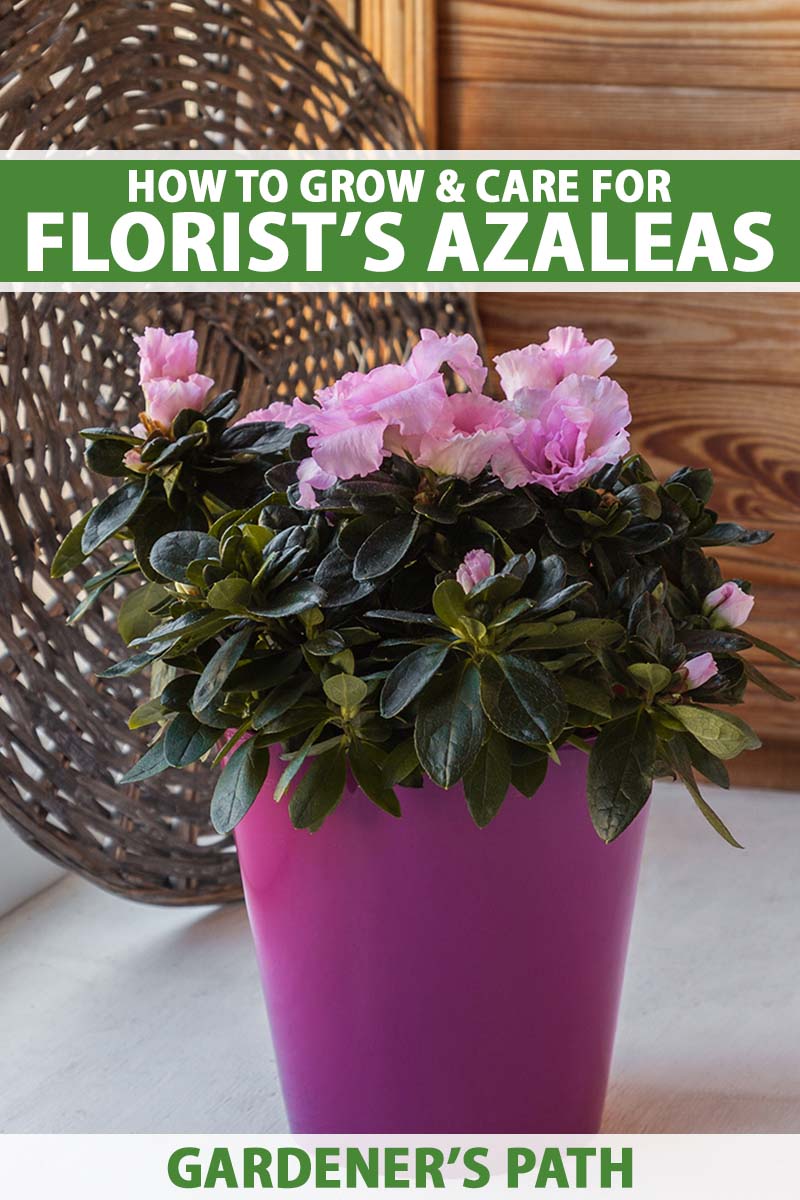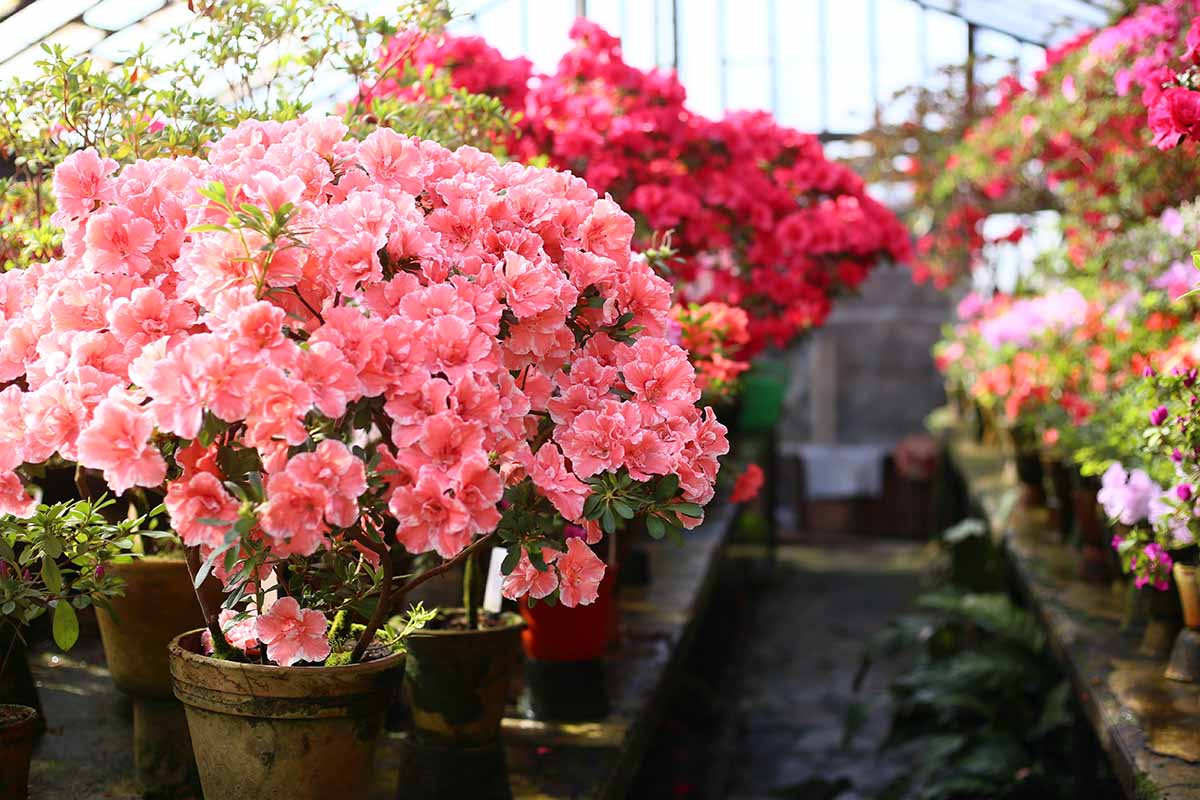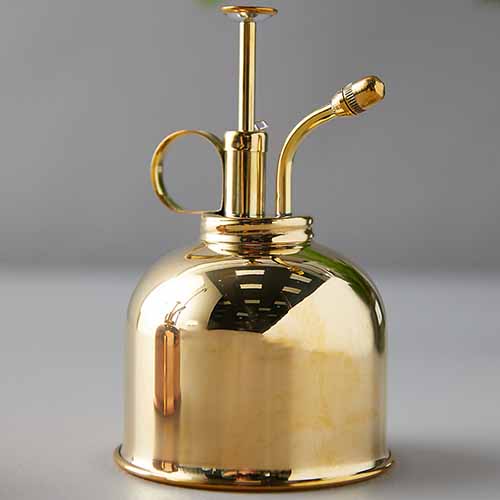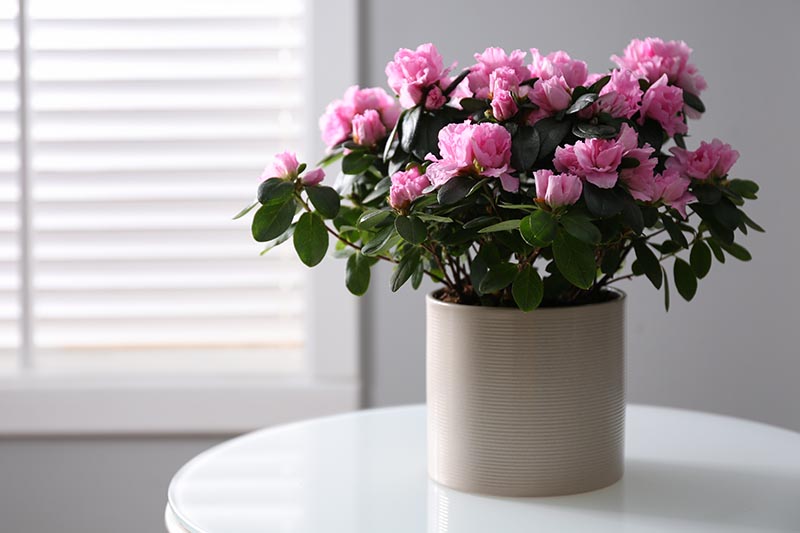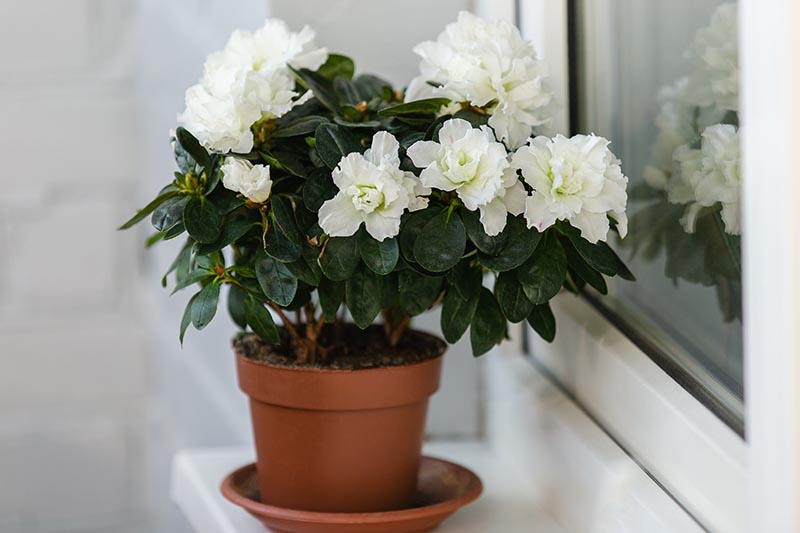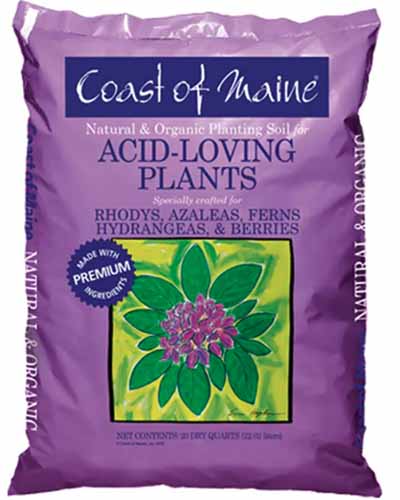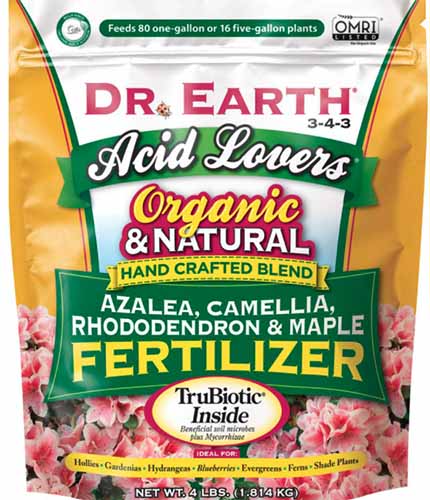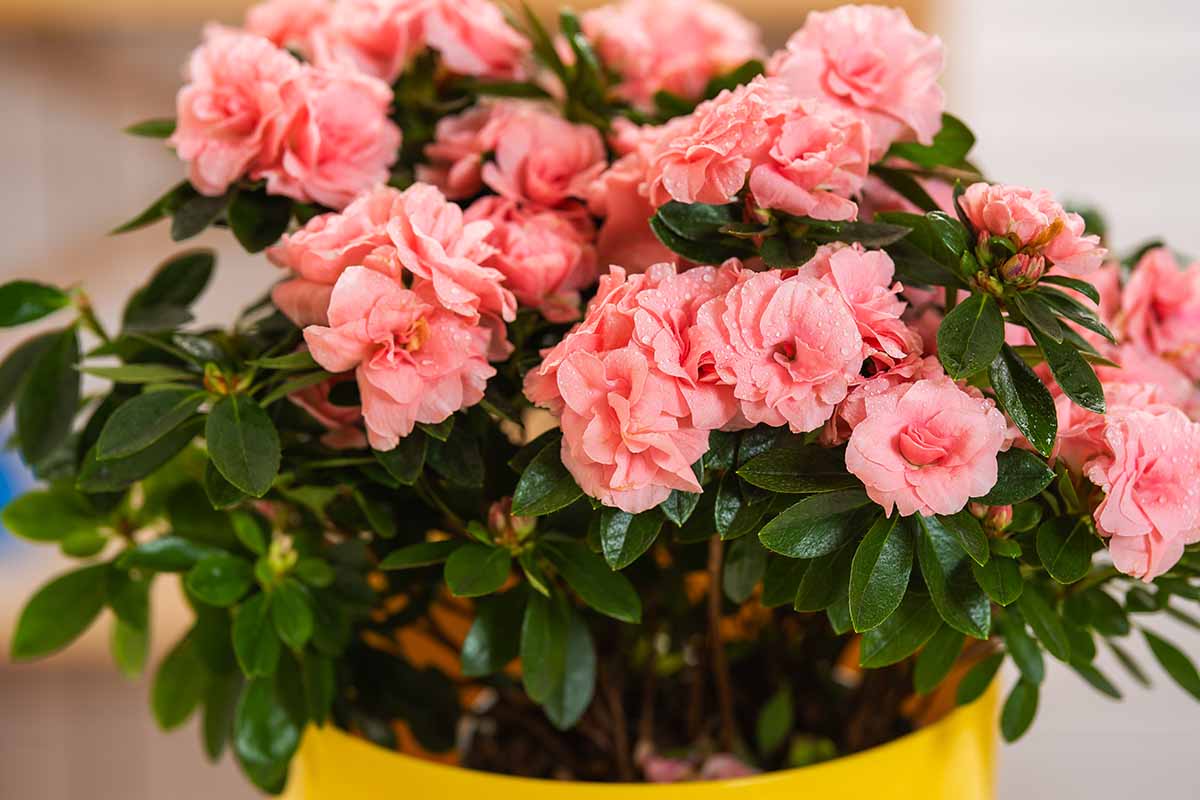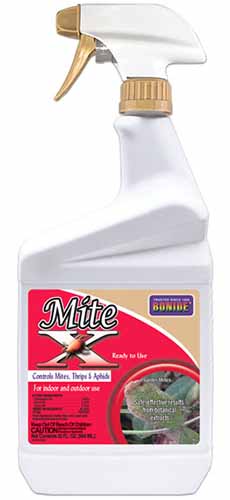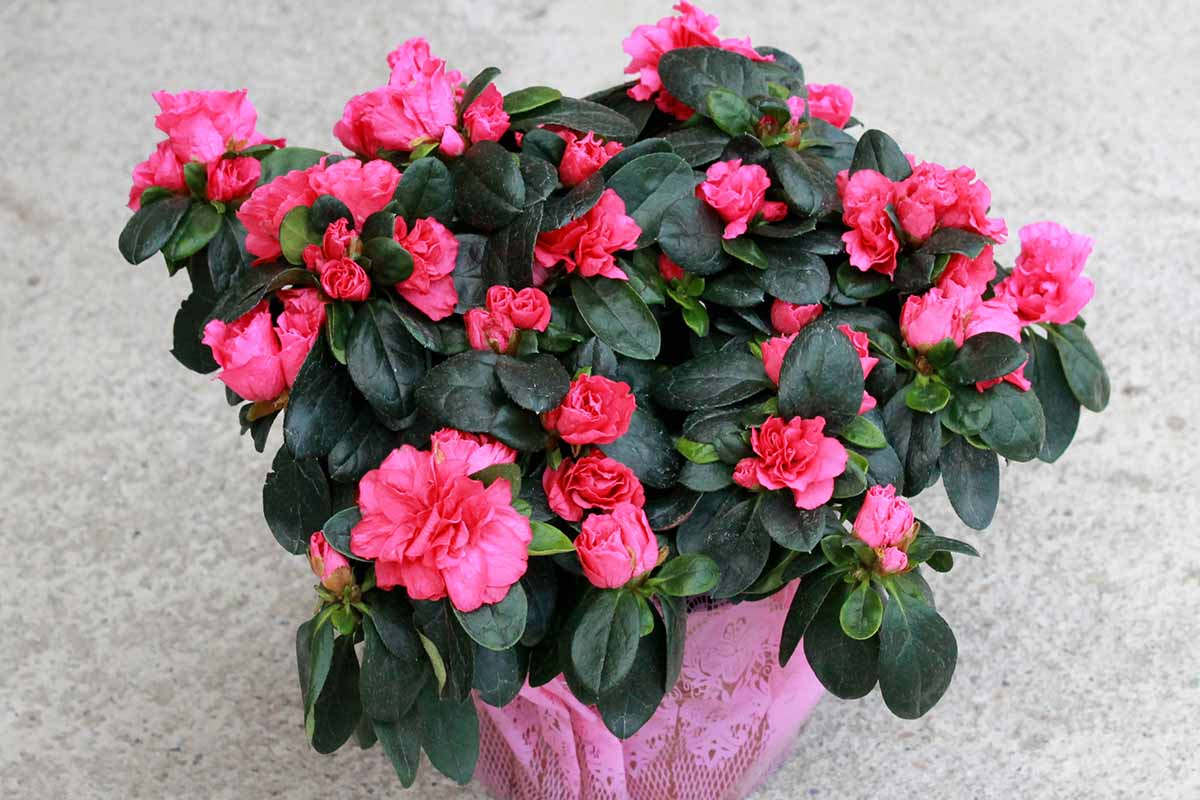Along with poinsettias, they’re often found at florists’ shops and grocery stores around the country during the holiday season. But are these azaleas (Rhododendron simsii) viable as long-term houseplants? Will they bloom again? You might be asking yourself these questions and more, especially if a friend has just gifted you a graceful, flowering houseplant with a base wrapped in shiny foil. In this guide, we’ll answer all of your questions. We link to vendors to help you find relevant products. If you buy from one of our links, we may earn a commission. Here’s what we’ll cover:
What Are Florist’s Azaleas?
Azaleas are perennial flowering shrubs in the Rhododendron genus and the heath or heather family, Ericaceae, of which blueberries are also a part. In this guide, we’ll be talking about evergreen cultivars and hybrids of R. simsii, as these are the ones commonly grown as houseplants, and given as gifts during the holidays. They typically top out at 18 inches tall and wide when grown indoors. This species is native to parts of eastern Asia and in their natural habitat, plants can grow up to six feet tall and wide. Though they are evergreen, these shrubs have a unique leaf system. There are two sets: leaves that emerge in the spring, which are thin and about two inches long. These turn yellow and fall off in the fall, but not before the small, thick summer leaves emerge. The leaves hang on through wintertime before they fall off in the spring after the new leaves have come out. Flowers are most often white, purple, pink, red, or salmon. Single flowers have five petals, five to 10 stamens, and one pistil. Flowers can be single-flowered, or semi-double and double-flowered, wherein some or all of the stamens become petals. These plants prefer acidic soil, with a pH of 4.5 to 6.0. When grown indoors they like to receive eight hours of bright indirect light every day. They prefer indoor temperatures of between 60 and 65°F, especially when they’re actively blooming. To learn more about azaleas and how to grow them in the garden, check out our guide. Like autumn mums and winter poinsettias, the azaleas purchased from florists or grocery stores are often grown as short-lived houseplants. They are forced to bloom during the winter months by careful manipulation of their growing conditions. Holiday shrubs are propagated in tightly controlled conditions in a greenhouse, and it’s a shock to the plant’s system to come to your home with its completely different temperature, humidity, and light conditions. Once the blooms fade, these plants are typically thrown out because they’re considered hard to keep alive, and even harder to force to bloom again. But with the right care, they can continue to grow and bloom for years. Plus, they can be propagated easily from cuttings, so you can make new plants to fill your home and share with friends.
Propagation
By far the most common way that gardeners, florists, and other commercial growers propagate florist’s azaleas is by taking softwood cuttings. Since this method is easy to do indoors at home, it’s the one we’ll cover here. But note that these plants can also be propagated by planting seed (although hybrid varieties won’t grow true to the parent plant), by grafting, and by tip layering. Choose an eight- to 10-inch container with drainage holes. Fill with potting mix, and dig a hole as wide and deep as the root ball on your cutting.
A potting mixture made of half perlite and half peat moss, or two parts potting mix and one part perlite.A spray bottle filled with water.Pruning shears.Rooting hormone powder, like this one from Bonide, available at Arbico Organics.A heat mat, like this one from the Home Depot.Transparent plastic cups or containers (one for each cutting you plan to take) with drainage holes poked in the bottom.Seven-inch humidity domes, like these from the Home Depot.
Fill the containers with the potting mixture and spray with water to moisten. Select a young branch that’s light in color. With your sanitized pruning shears, cut the branch three to six inches down from the tip. Remove any leaves from the bottom half of the cutting. Using your pruners or a sharp knife, scrape away the bark on the bottom inch of the cutting and dip it in the rooting hormone powder. Stick the cutting in the potting mixture, placing one in each cup. Set the cups together on the warm heat mat, spray the soil with the misting bottle, such as this one from Terrain, and cover with a humidity dome. Haws Plant Mister Make sure the mat is located in a spot that receives at least six hours of indirect sunlight every day. Keep the seedlings warm and watered, and you should see roots developing within four to eight weeks, at which point you can transplant them to a larger pot. Gently remove the rooted cutting from its original container, soil and all, and tuck it into the waiting pot. Backfill with potting mix and water it thoroughly before placing the pot in a location where it will receive at least six hours of bright, indirect sunlight every day.
How to Grow
When you first bring your florist’s azalea home from the store, don’t rush to transplant it. Remove any decorative outer foil or wrapping from around the plant as this can inhibit drainage. Set it in a location with bright, indirect light, where the temperature remains a constant 60 to 65°F. Avoid placing it near heating vents, doors that open and close regularly, or in areas that have dramatic temperature fluctuations. Water every few days, allowing the top half inch of potting mix to dry out between waterings. Avoid watering the leaves. And don’t ever let the soil completely dry out – this is one of the main reasons florist’s azaleas die. Ideally, you should use distilled water or rainwater to hydrate your plant, as municipal water is generally too alkaline, particularly if you live in a hard-water area. In general, florist’s azaleas bought from the store come potted in peat moss and nothing more. Peat moss can dry out quickly if you forget to water it for even a few days. If the plant’s leaves begin to drop and the potting medium feels bone-dry, immerse the base of the plant, pot and all, in a container of lukewarm water for 15 minutes. Set the pot in the sink to allow it to drain excess water, and your azalea should spring back to life. Try to keep the area around the plant humid by setting the pot on a plastic tray, filling the tray with pebbles, and watering the rocks every other day. Your plant will thrive in the container it came in until the blooms fade, typically a few weeks after purchase.
Growing Tips
Provide bright indirect sunlight.Water every couple of days or more often as needed, taking care to only let the top half inch of soil dry out.Fertilize with a product for acid-loving plants during active growth, but not during blooming.Set pots on a tray filled with pebbles and water to maintain humidity around the plant.
Pruning and Maintenance
Florist’s azaleas don’t need heavy pruning. You can deadhead spent flowers to encourage your plant to produce new blooms, and remove any broken, dead, or diseased branches. Azaleas love slightly acidic soil with a pH of 4.5 to 6.0. Coast of Maine Potting Soil When repotting, it’s best to purchase a potting soil specifically designed for azaleas, such as this one from Coast of Maine, available from Home Depot. After the plant has finished flowering, fertilize every two weeks with a mix meant for acid-loving plants, applied according to package instructions. Dr. Earth Acid Lovers Fertilizer I prefer this fertilizer from Dr. Earth, which is available at the Home Depot. If the plant looks scraggly after blooming and you want to retain a rounded shape, feel free to trim any wayward branches with a pair of clean pruning shears if you wish. Don’t prune more than a third of the branches at one time, preferably less. In order for these plants to bloom, they need a chilling period of about two months with temperatures between 40 to 50°F. Commercial growers achieve this by keeping the plants in controlled environments so that they bloom in time for the holidays. You can replicate this by placing your plant in a basement or other suitable location. Reduce watering during this period, but do not allow the soil to completely dry out. After two months of cooler temperatures, move your plant to a spot with consistent temperatures of 60 to 65°F for the flower buds to form. During the summer months, after all risk of frost has passed, you can place your plant outdoors in a protected area on your porch or patio. Always remember to harden it off gradually over the course of a week to 10 days, by placing the plant outdoors for increasing amounts of time. Bring your florist’s azalea back indoors before first frost – exposure to freezing temperatures, even for a short time, will kill the plant. Plan well in advance so that you can acclimate your plant to indoor conditions gradually. Bring it indoors for increasing amounts of time over the course of a week. Avoid repotting often: let the plant make a home in the pot you transplant it to after you purchase it, and keep it there for at least three years at a time.
Managing Pests and Disease
Grown indoors, these houseplants aren’t plagued by much in the way of pests and diseases.
Christmas Cheer
With ruffled, double-flowered blooms in red and white contrasted against dark green leaves, ‘Christmas Cheer’ is the perfect houseplant to raise your spirits during the holidays – and long after they end. ‘Christmas Cheer’ It’s available in a cute wooden container that you can use for display through the holidays before transplanting it to a pot with better drainage. Find ‘Christmas Cheer’ in a four-inch container online from Bower & Branch, via Nature Hills Nursery.
Snowflake
No snow in your area? No problem. Just bring home a topiary ‘Snowflake’ azalea, grown on braided branches to resemble a small tree topped with snow-white, double-flowered, ruffled blooms. ‘Snowflake’ You can purchase your own plant in a four-inch wooden container online from Bower & Branch, available via Nature Hills Nursery.
Reindeer Red
Brighten your home with ‘Reindeer Red,’ its cheery red, ruffled blooms contrasting with the deep green foliage. ‘Reindeer Red’ You can find ‘Reindeer Red’ in a rustic wooden planter available from Bower and Branch via Nature Hills Nursery. It’s possible that your plants could develop root rot if you water too much – or if the pot or the soil isn’t well draining. Unfortunately, this typically means the end of your plant, so your best bet is to keep the soil moist but not waterlogged, and always avoid watering the leaves as a means of prevention.
Best Uses
Clearly the best way to use these potted plants is to let them provide a touch of good cheer in the middle of a dreary winter. If that telltale cottony webbing and those pinprick-sized mites appear on the foliage, immediately remove the webbing, mites, and affected leaves. Bonide Mite-X You can spray the plant with Bonide’s Mite-X, available from Arbico Organics. Learn more about how to deal with spider mites in our guide. Since they’re so easy to propagate, they can also provide a rewarding early-spring activity for you, by growing new plants from cuttings. Either give the new indoor azaleas away to your friends, or keep them for yourself, filling your entire home with brightness and beauty. What’s your favorite thing about these lovely flowers? Leave your questions and stories in the comments section below. And in the meantime, read these articles on growing azaleas next:
How to Grow and Care for Azaleas in Containers Azalea Bloom Times and Flowering GroupsHow to Propagate Azaleas for Gorgeous New Shrubs
